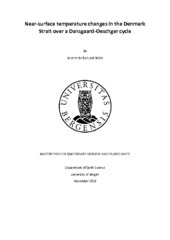Near-surface temperature changes in the Denmark Strait over a Dansgaard-Oeschger cycle
Master thesis
Permanent lenke
https://hdl.handle.net/1956/18841Utgivelsesdato
2018-12-15Metadata
Vis full innførselSamlinger
- Department of Earth Science [1034]
Sammendrag
The Greenland ice core record shows large and abrupt temperature increases that interrupted the cold climate of the last glacial period. These events, known as Dansgaard-Oeschger (D-O) events have been linked with climate records from North Atlantic and Nordic Seas sediments. Mechanisms determining the timing and amplitude of the Greenland temperature signal are thought to comprise variations in oceanic heat transport resulting from freshwater perturbations and variations in the Nordic Seas sea ice extent. While most studies on the near-surface Nordic Seas role in D-O events have been conducted in the south-eastern part of the Nordic Seas, I here present the first near-surface Mg/Ca temperature record over D-O events from the Denmark Strait. The record is coupled with δ18O and δ13C records obtained from the shells of the planktonic foraminiferal species Neogloboquadrina pachyderma and covers the interval Greenland Interglacial 9 (GI9) to Greenland Interglacial 8 (GI8) with 30-year temporal resolution. Two different cleaning protocols were applied prior to Mg/Ca measurement: the “Cd-cleaning” method and the “full-cleaning” method. Ratios of Al/Ca and other elemental ratios of potential contaminants decrease to some extent after the “full-cleaning” method compared with the “Cd-cleaning” method, yet the different cleaning methods yield similar results in terms of Mg/Ca. Mg/Ca reconstructed temperatures are largely in agreement with temperature reconstructions in the south-east Nordic Seas indicating that planktonic Mg/Ca temperature reconstruction is feasible during the last glacial period in the Denmark Strait. Subsurface waters were relatively warm during Heinrich Stadial 4 (HS4) with temperatures at ~4-5°C while δ18Osw and δ13C were low. Together, this suggests that the subsurface waters were covered by a lid of fresher surface water and sea ice. Over the transition to GI8, temperatures dropped by ~3°C, δ18Osw increased by ~1‰, and δ13C increased by ~0.3‰ indicating a reorganization of the upper water column. The transition took place over centuries, which is slower than expected for this particular site. The site is therefore not likely to be directly involved in the abrupt heat release and sea ice diminution that is thought to cause decade-scale warming on Greenland. Temperature variations with increasing amplitude through GI8 are observed in the record, indicating an instable halocline and variations in local ventilation.
